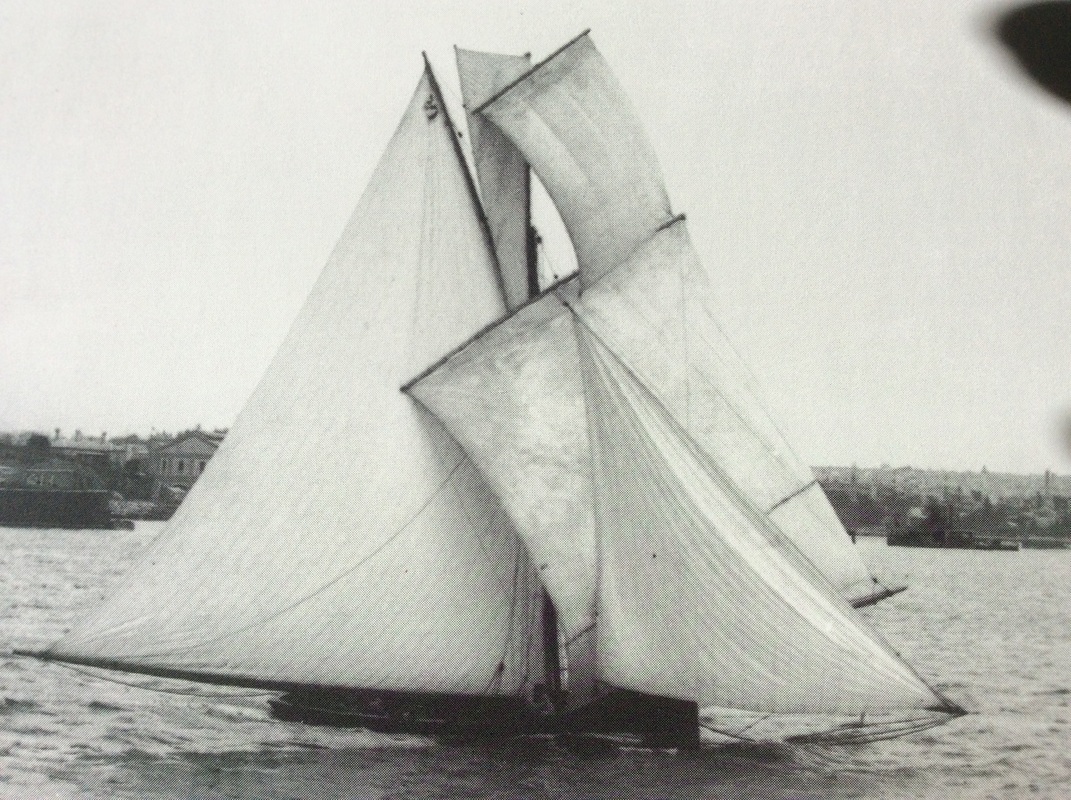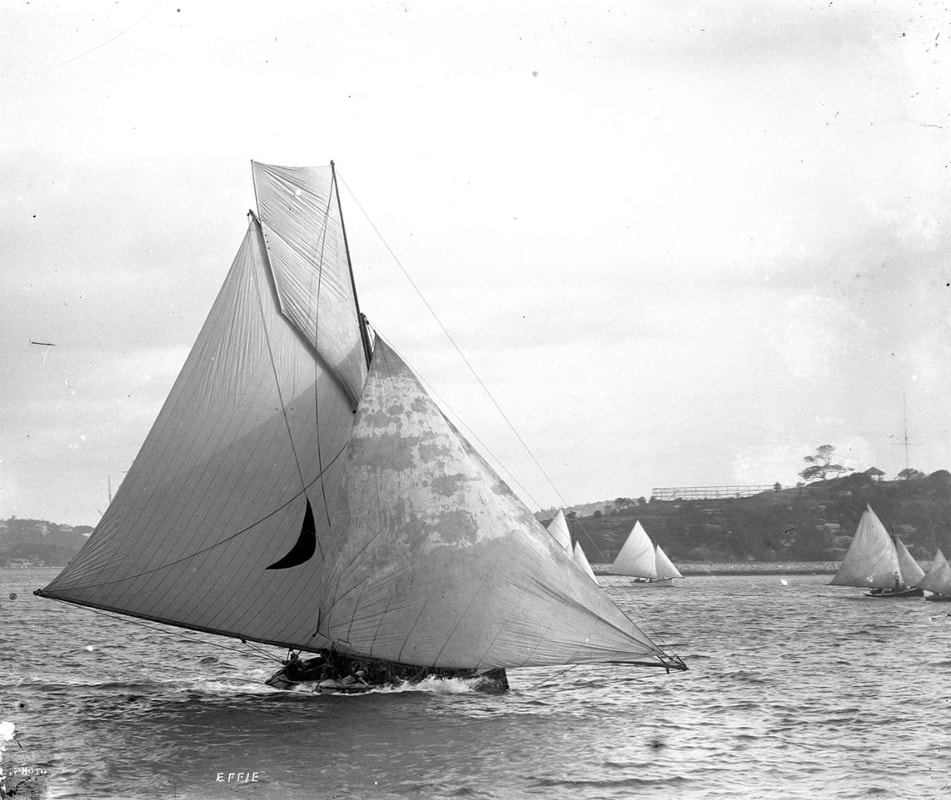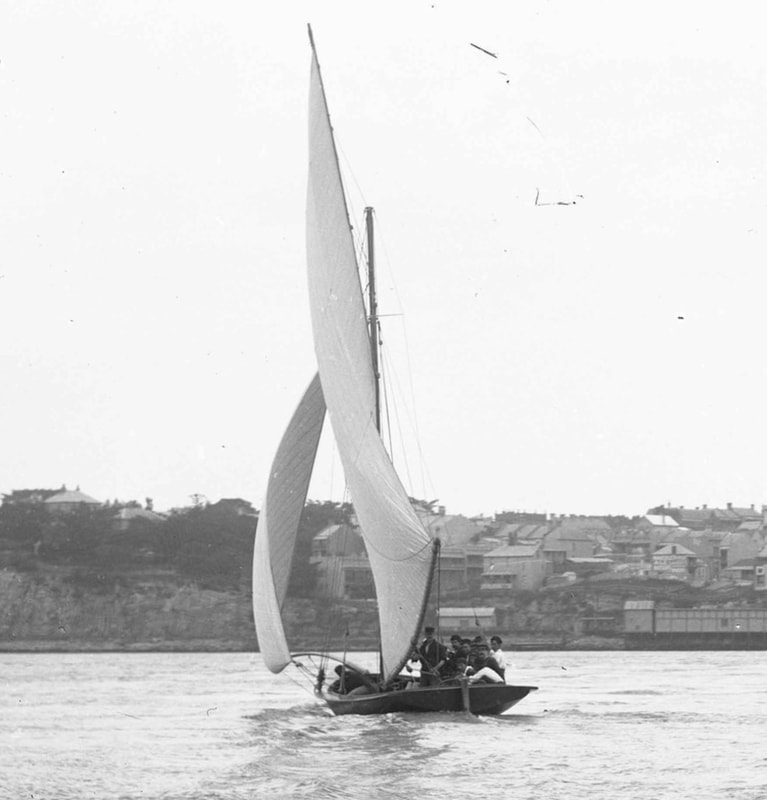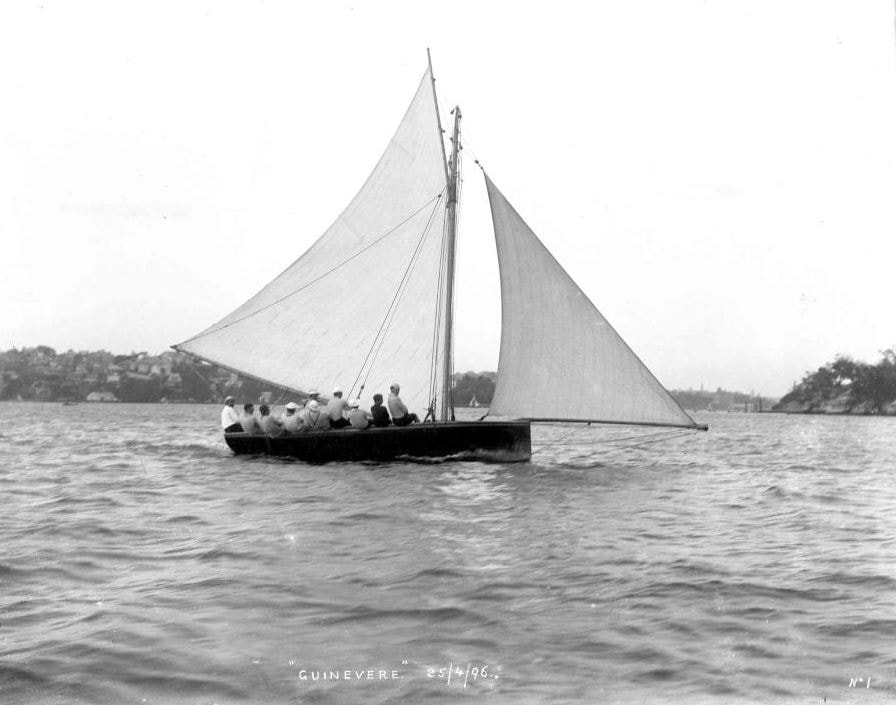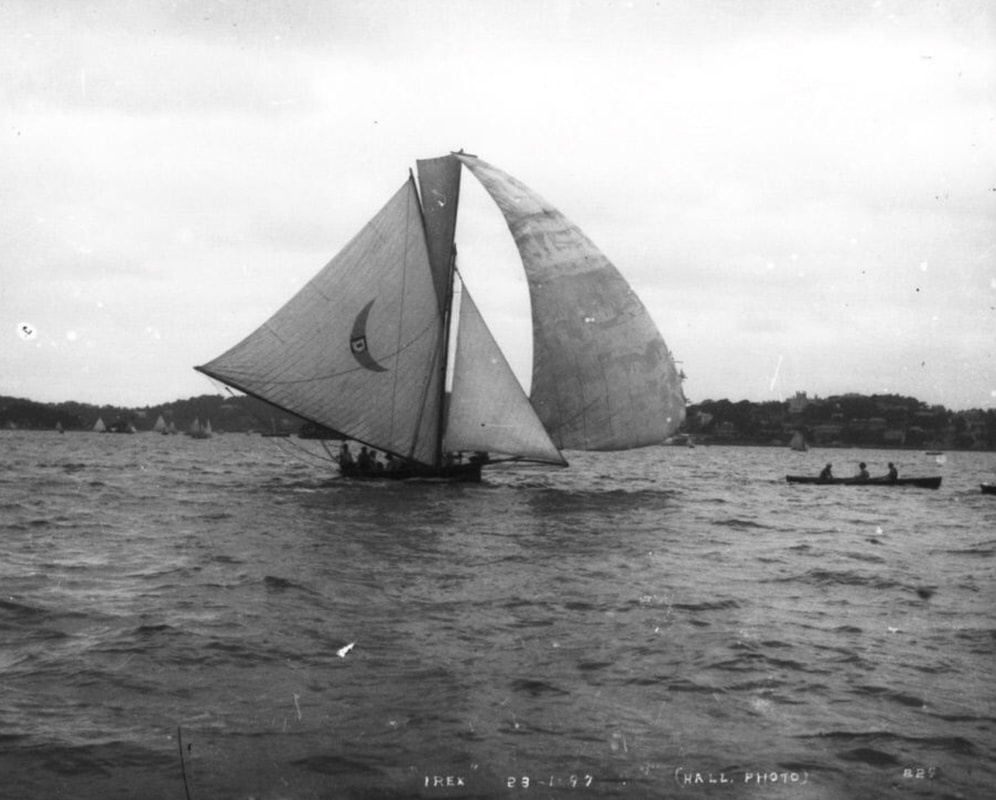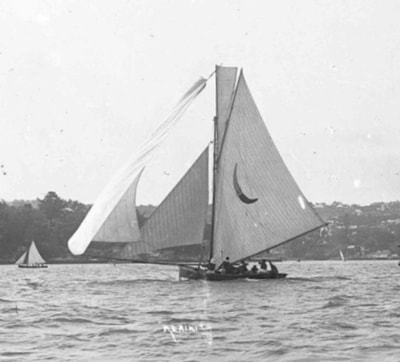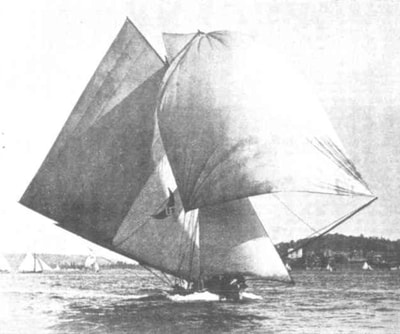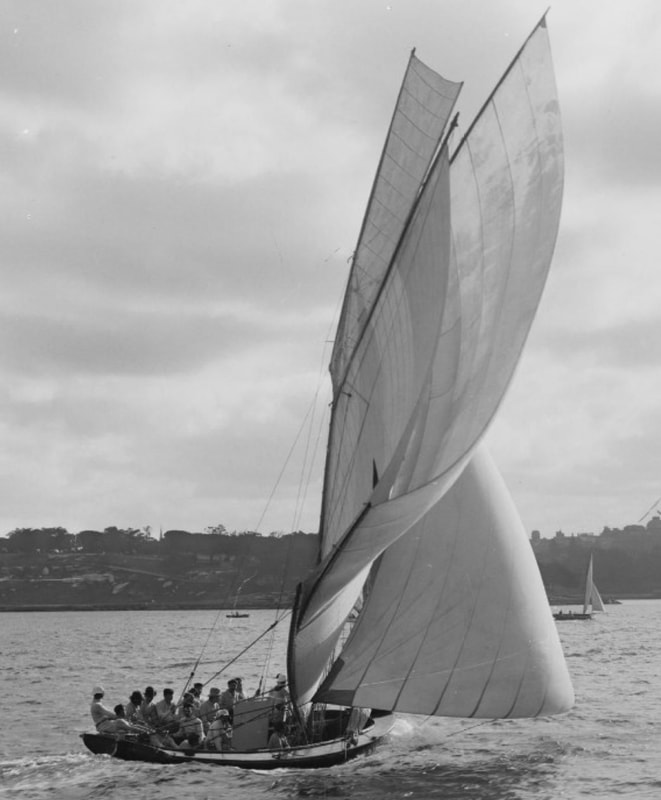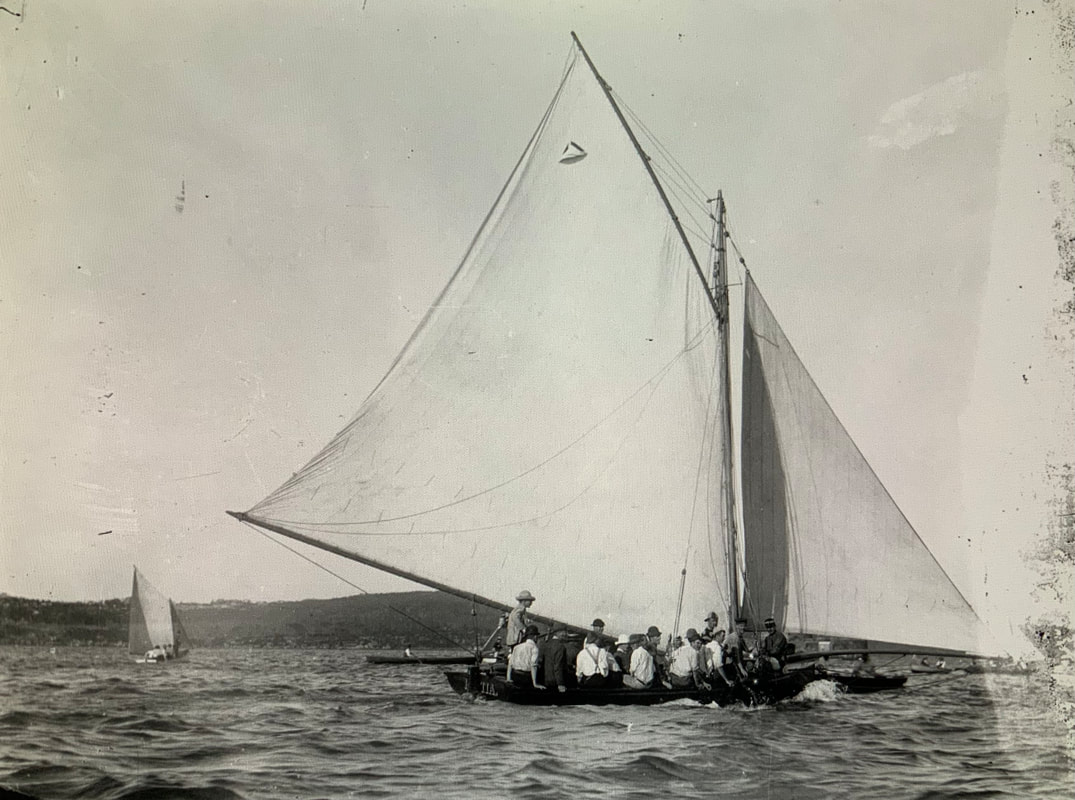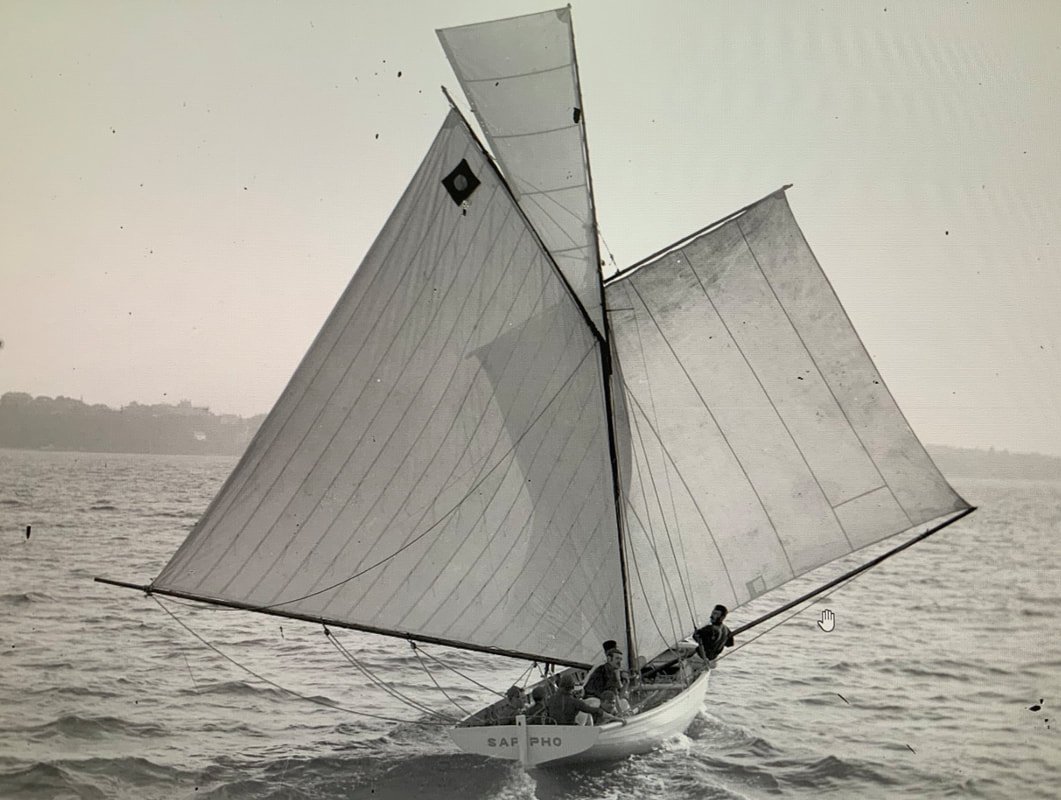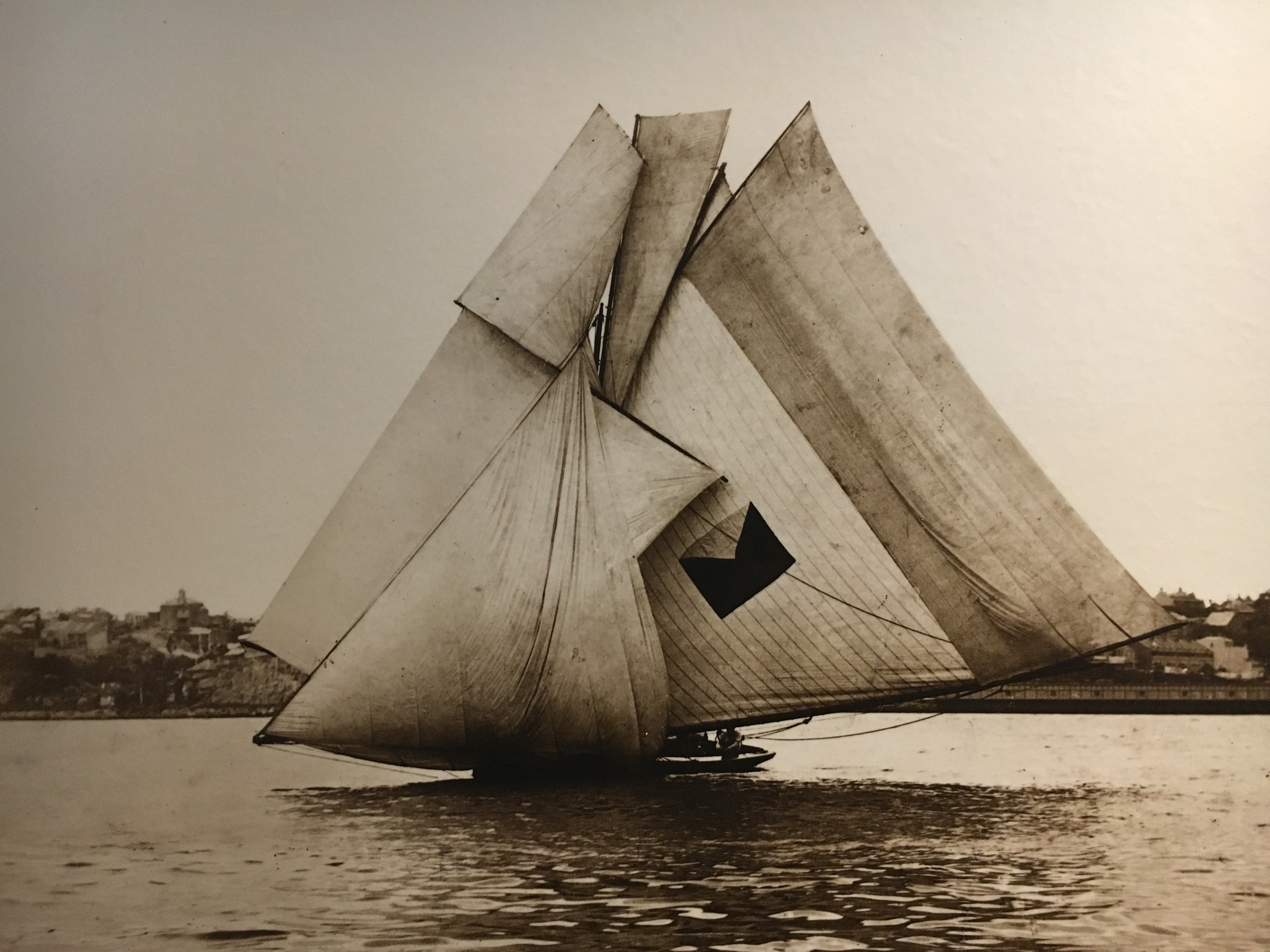The 22-footers began to appear in the 1880's as a smaller version of the 24-footers, but very soon boats were being built specifically to race, and most of the features of the eighteen footers of the early twentieth century developed in 22-footers in the next couple of decades. They took over as the dominant class from the 24-footers in the mid-1890's, largely due to the impetus of Intercolonial racing with Brisbane boats. They faded after the turn of the century and were supplanted as the dominant class by the 18-footers in 1903.
This list will be continually added to, there were at least 54 twenty-two footers built.
This list will be continually added to, there were at least 54 twenty-two footers built.
Bulletin 1889
Builder: J.McCleer, Brisbane, but Billy Golding* from Sydney claimed to have sold him the moulds.
When launched in 1889 it was commented that she was varnished both inside and out, noted because a number of the 22' boats racing in Brisbane were still working oyster boats on Moreton Bay and were painted.
Known dimensions:Length 22'
Bulletin was the Queensland Champion for most of the 1890's, and won several races associated with the Intercolonial Challenges from 1894 to 1899, but in those days the actual Championship was decided on one race, and Bulletin was not lucky enough to win any of these. She was mostly steered by J.H.(Jack) Whereat, who also had a hand in building her and was either one of a syndicate, or the sole owner.
Note the bonnet, an extension laced to the bottom of the squaresail, and the raffee slung from the peak of the jackyard tops'l.
She was renamed Ruby and was wrecked in a gale near Bowen in Far North Queensland in 1916.
When launched in 1889 it was commented that she was varnished both inside and out, noted because a number of the 22' boats racing in Brisbane were still working oyster boats on Moreton Bay and were painted.
Known dimensions:Length 22'
Bulletin was the Queensland Champion for most of the 1890's, and won several races associated with the Intercolonial Challenges from 1894 to 1899, but in those days the actual Championship was decided on one race, and Bulletin was not lucky enough to win any of these. She was mostly steered by J.H.(Jack) Whereat, who also had a hand in building her and was either one of a syndicate, or the sole owner.
Note the bonnet, an extension laced to the bottom of the squaresail, and the raffee slung from the peak of the jackyard tops'l.
She was renamed Ruby and was wrecked in a gale near Bowen in Far North Queensland in 1916.
Caneebie 1891
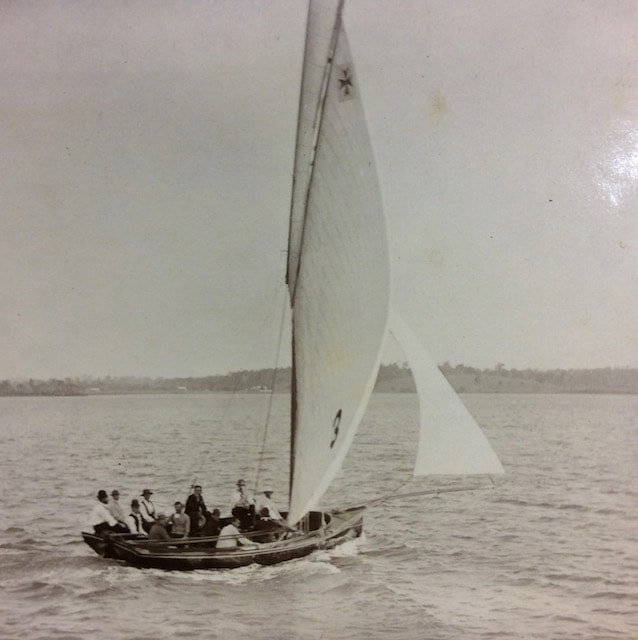
Builder: William Golding* in Sydney for T.Goodall in Brisbane.
Known dimensions: 9'6" beam, 3' deep.
Planking Cedar, ribs Ash (Silver Ash), decking Australian Rosewood. Varnished, with a gold stripe.
Caneebie's first race appears to be a general handicap of the Brisbane Sailing Club in November 1891 in which she came third. Other placings follow that season under the owner T.Goodall. Her first win appears to be in the following season when Goodall steered her to third in a race from Hamilton Reach to Cleveland on the Bay.
Her racing life was a close contest for number one in Brisbane against Bulletin*. In November 1893 Caneebie beat Bulletin in the Humpybong Regatta and repeated the feat several times but was more often beaten by Bulletin. The racing was close and included at least one protest after collision. The 22-footers received a boost when three Sydney boats (Latona, Portia and Irex*) came up to Brisbane in March 1894 for the first Intercolonial Challenge. Caneebie was unplaced in the invitational race won by Bulletin, but the Sydney boat Irex won the one-race Championship, and Caneebie was second. Caneebie didn't feature in the return match in Sydney in January 1895, won by Esmerelda. But in December 1895 when the Sydney boats returned to Brisbane for the contest on Moreton Bay Caneebie won the Championship. The above photograph is from that series. It is from the collection of the builder William Golding who appears to have travelled there as a spectator. The Golding family donated the collection to the Australian National Maritime Museum.
As well as continuing local racing with success, Caneebie travelled to Sydney for the January 1897 Intercolonial Challenge but was unplaced. She came second in the 1898 Championship in Brisbane (to the new Sydney wonder boat Effie). I'm not sure if she travelled to Sydney for the last Intercolonial in 1899, and her trail grows a little cold after that. It appears she may have been sold to Sydney at some stage as the last race I can find a record of her in is a general handicap in the January 1913 Anniversary Day Regatta in Sydney.
Known dimensions: 9'6" beam, 3' deep.
Planking Cedar, ribs Ash (Silver Ash), decking Australian Rosewood. Varnished, with a gold stripe.
Caneebie's first race appears to be a general handicap of the Brisbane Sailing Club in November 1891 in which she came third. Other placings follow that season under the owner T.Goodall. Her first win appears to be in the following season when Goodall steered her to third in a race from Hamilton Reach to Cleveland on the Bay.
Her racing life was a close contest for number one in Brisbane against Bulletin*. In November 1893 Caneebie beat Bulletin in the Humpybong Regatta and repeated the feat several times but was more often beaten by Bulletin. The racing was close and included at least one protest after collision. The 22-footers received a boost when three Sydney boats (Latona, Portia and Irex*) came up to Brisbane in March 1894 for the first Intercolonial Challenge. Caneebie was unplaced in the invitational race won by Bulletin, but the Sydney boat Irex won the one-race Championship, and Caneebie was second. Caneebie didn't feature in the return match in Sydney in January 1895, won by Esmerelda. But in December 1895 when the Sydney boats returned to Brisbane for the contest on Moreton Bay Caneebie won the Championship. The above photograph is from that series. It is from the collection of the builder William Golding who appears to have travelled there as a spectator. The Golding family donated the collection to the Australian National Maritime Museum.
As well as continuing local racing with success, Caneebie travelled to Sydney for the January 1897 Intercolonial Challenge but was unplaced. She came second in the 1898 Championship in Brisbane (to the new Sydney wonder boat Effie). I'm not sure if she travelled to Sydney for the last Intercolonial in 1899, and her trail grows a little cold after that. It appears she may have been sold to Sydney at some stage as the last race I can find a record of her in is a general handicap in the January 1913 Anniversary Day Regatta in Sydney.
Effie 1896
Builder: Joe Donnelly* for Mr J.McMurtrie.
Known dimensions: Variously quoted as 9'7" or 9'!0" beam, 2'7 1/4" deep, "immense spring in keel" of 9".
Sail Insignia: Black crescent.
Effie debuted at the Johnstones Bay Sailing Club handicap race on Saturday 5 December 1896, after being launched that morning, and won the race under the owner Jim McMurtrie off scratch, using sails from his 24-footer Ida. She won again a fortnight later, and again in her third race on 9 January 1897, and hopes were high for her in the 22-Footers Intercolonial Championship on 23 January in Sydney, but she was unplaced. Dismasted in the Anniversary Day Regatta Intercolonial Challenge race on 25 January, Effie capsized in the next event, the SFS Intercolonial race on Sat 30 January, and was unplaced in the next race, a JBSC handicap on 6 Feb. McMurtie coaxed an old professional Nick Johnson out of retirement to steer her on 13 Feb but the jib carried away. Things improved a bit when Effie won off scratch in the last race of the JBSC season on 3 April under Nick Johnson. Both Effie and Golding's* Vigilant* sailed to Gosford for the Regatta at Easter and were weather-bound there for a week before returning. At some stage in her first season she is alleged to have been the first open boat to set a spinnaker, albeit one with a short spar at the head. Apparently when she first set it there was consternation among the onlookers who thought that something had carried away!
In the 1897-98 season McMurtrie started in a few races without success, but Nick Johnson got into third in the JBSC's ocean race on 30 October (the boats raced to a buoy four miles to windward (N.E.) of South Reef). In the 22-Footers Championship race on 28 November Effie under Nick Johnson had a great tussle with Vigilant was but just beaten on the line.
Effie travelled to Brisbane for the 1897-98 Intercolonials and won the Championship race, plus two more races. On returning to Sydney she won the 22-footers race at the Anniversary Day Regatta. In 20 races up to March that season, Effie won 9, was second 5 times, third once and unplaced only 5 times. In the 3 remaining events, she won 2 of her heats. N.Johnson steered on 15 occasions out of the 20. She won another one or two races in late March and early April.
In the 1898-99 season Effie continued her run of victories, other than the first race of the season where she was beaten by Donnelly's new 22-footer for Mr Sam Hordern Plover.* Effie again won the Intercolonial Championship in Sydney in January 1899. Effie was reported as being for sale in February 1899. This may have happened as McMurtrie sailed a yacht in the next season (and then died of pneumonia in September 1901). The new owner appears to be a Mr E.E.Sayer.
She was still the dominant boat in the 1899-1900 season. The Queenslanders dropped out of Intercolonial competition, and many of the Sydney 22's stopped racing. There was much talk that the cheaper Rater-type yacht would soon replace the 22's, and several raters did begin to race on the Harbour (see HORSES FOR COURSES- OPEN BOATS AND RATERS on the YARNS Page). A challenge series between Effie and a rater was won 3-nil by Effie, and the crowds on the steamers seemed to want to still support the 22's.
For several more seasons the 22's sailed on with Effie, Plover and Keriki the most regular, but with rarely more than 5 boats in a fleet. Most of their weekly racing was in General Handicaps with the 18-footers which were rising in numbers and popularity with the punters. The owner bought new sails for the 1903-4 season. Various skippers handled the boat during these few seasons. But by 1910 only Keriki and Effie were sailing with the SSC and SFS. After that the trail of Effie runs cold, but the Australian Motor Boating and Yachting magazine claimed in 1925 that she had been taken to the Hawkesbury (the River flowing into Broken bay, the next estuary North of Sydney Harbour) and fitted with an engine.
In the opinions of the time she was generally rated as the best 22-footer of all.
Known dimensions: Variously quoted as 9'7" or 9'!0" beam, 2'7 1/4" deep, "immense spring in keel" of 9".
Sail Insignia: Black crescent.
Effie debuted at the Johnstones Bay Sailing Club handicap race on Saturday 5 December 1896, after being launched that morning, and won the race under the owner Jim McMurtrie off scratch, using sails from his 24-footer Ida. She won again a fortnight later, and again in her third race on 9 January 1897, and hopes were high for her in the 22-Footers Intercolonial Championship on 23 January in Sydney, but she was unplaced. Dismasted in the Anniversary Day Regatta Intercolonial Challenge race on 25 January, Effie capsized in the next event, the SFS Intercolonial race on Sat 30 January, and was unplaced in the next race, a JBSC handicap on 6 Feb. McMurtie coaxed an old professional Nick Johnson out of retirement to steer her on 13 Feb but the jib carried away. Things improved a bit when Effie won off scratch in the last race of the JBSC season on 3 April under Nick Johnson. Both Effie and Golding's* Vigilant* sailed to Gosford for the Regatta at Easter and were weather-bound there for a week before returning. At some stage in her first season she is alleged to have been the first open boat to set a spinnaker, albeit one with a short spar at the head. Apparently when she first set it there was consternation among the onlookers who thought that something had carried away!
In the 1897-98 season McMurtrie started in a few races without success, but Nick Johnson got into third in the JBSC's ocean race on 30 October (the boats raced to a buoy four miles to windward (N.E.) of South Reef). In the 22-Footers Championship race on 28 November Effie under Nick Johnson had a great tussle with Vigilant was but just beaten on the line.
Effie travelled to Brisbane for the 1897-98 Intercolonials and won the Championship race, plus two more races. On returning to Sydney she won the 22-footers race at the Anniversary Day Regatta. In 20 races up to March that season, Effie won 9, was second 5 times, third once and unplaced only 5 times. In the 3 remaining events, she won 2 of her heats. N.Johnson steered on 15 occasions out of the 20. She won another one or two races in late March and early April.
In the 1898-99 season Effie continued her run of victories, other than the first race of the season where she was beaten by Donnelly's new 22-footer for Mr Sam Hordern Plover.* Effie again won the Intercolonial Championship in Sydney in January 1899. Effie was reported as being for sale in February 1899. This may have happened as McMurtrie sailed a yacht in the next season (and then died of pneumonia in September 1901). The new owner appears to be a Mr E.E.Sayer.
She was still the dominant boat in the 1899-1900 season. The Queenslanders dropped out of Intercolonial competition, and many of the Sydney 22's stopped racing. There was much talk that the cheaper Rater-type yacht would soon replace the 22's, and several raters did begin to race on the Harbour (see HORSES FOR COURSES- OPEN BOATS AND RATERS on the YARNS Page). A challenge series between Effie and a rater was won 3-nil by Effie, and the crowds on the steamers seemed to want to still support the 22's.
For several more seasons the 22's sailed on with Effie, Plover and Keriki the most regular, but with rarely more than 5 boats in a fleet. Most of their weekly racing was in General Handicaps with the 18-footers which were rising in numbers and popularity with the punters. The owner bought new sails for the 1903-4 season. Various skippers handled the boat during these few seasons. But by 1910 only Keriki and Effie were sailing with the SSC and SFS. After that the trail of Effie runs cold, but the Australian Motor Boating and Yachting magazine claimed in 1925 that she had been taken to the Hawkesbury (the River flowing into Broken bay, the next estuary North of Sydney Harbour) and fitted with an engine.
In the opinions of the time she was generally rated as the best 22-footer of all.
Esmerelda 1889
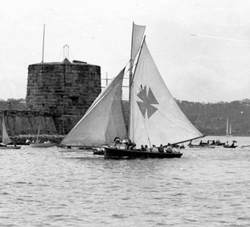
Builder: J.Hayes, Balmain, for himself.
Sail Insignia: Blue Maltese cross.
Esmerelda was launched in September 1889 and is reported to have "gone well" on her first outing under "Cubby" Holmes (George Holmes Jnr). Her first win appears to be in the Balmain Regatta that year with Holmes at the tiller. She raced with the JBSC and occasionally with the Port Jackson Sailing Club, an outfit that sailed hired boats, which suggests that Hayes chartered the boat out at times. I can find no record of Esmerelda winning any Championships in her first few seasons, but there were a few placings so she was up there. Cubby Holmes mostly steered her, but Hayes put Billy Read* in charge for the Intercolonial Championships in Sydney in January 1895 and he won the title. The accompanying photograph shows Esmerelda crossing the finishing line off Fort Denison in that Championship race. She was never able to reclaim that glory, but came close with a third in the JBSC 22' Championship in November 1897 but was outclassed in the 1897 Intercolonial Championship, the last one she contested. Details of her later career are slim. but she is reported to have been laid up in October 1901.
Sail Insignia: Blue Maltese cross.
Esmerelda was launched in September 1889 and is reported to have "gone well" on her first outing under "Cubby" Holmes (George Holmes Jnr). Her first win appears to be in the Balmain Regatta that year with Holmes at the tiller. She raced with the JBSC and occasionally with the Port Jackson Sailing Club, an outfit that sailed hired boats, which suggests that Hayes chartered the boat out at times. I can find no record of Esmerelda winning any Championships in her first few seasons, but there were a few placings so she was up there. Cubby Holmes mostly steered her, but Hayes put Billy Read* in charge for the Intercolonial Championships in Sydney in January 1895 and he won the title. The accompanying photograph shows Esmerelda crossing the finishing line off Fort Denison in that Championship race. She was never able to reclaim that glory, but came close with a third in the JBSC 22' Championship in November 1897 but was outclassed in the 1897 Intercolonial Championship, the last one she contested. Details of her later career are slim. but she is reported to have been laid up in October 1901.
Figtree 1896
Builder: R. Stephens of Blues Point for himself.
Known dimensions: Either 8'7" or 9'7" beam (probably the latter), 2'9" deep.
"Hollow midships".
One of the several new Sydney 22's to be launched for the 1897 Intercolonial Challenge, Figtree 's first race was in a JBSC handicap on 5 December 1896 and much was expected with Chris Webb at the tiller but the rudder carried away before the start. She was unplaced with Chris Webb again in her second race but had showed upwind form by being first to the top mark and covering rival Effie* all the way to the mark, but was unable to keep up downwind. In her third race she was second to Effie. This was to be the story of her short career. Both Effie and Vigilant seemed to have her mark. Tom Colebrook Junior sometimes took the tiller, but couldn't do any better than Webb. The prize money figures for the 1897-98 season tell the story: Figtree won a total of 14 pounds while Effie and Vigilant topped the pile with 40 pounds each. I can find no trace of Figtree after the 1897-98 season.
Known dimensions: Either 8'7" or 9'7" beam (probably the latter), 2'9" deep.
"Hollow midships".
One of the several new Sydney 22's to be launched for the 1897 Intercolonial Challenge, Figtree 's first race was in a JBSC handicap on 5 December 1896 and much was expected with Chris Webb at the tiller but the rudder carried away before the start. She was unplaced with Chris Webb again in her second race but had showed upwind form by being first to the top mark and covering rival Effie* all the way to the mark, but was unable to keep up downwind. In her third race she was second to Effie. This was to be the story of her short career. Both Effie and Vigilant seemed to have her mark. Tom Colebrook Junior sometimes took the tiller, but couldn't do any better than Webb. The prize money figures for the 1897-98 season tell the story: Figtree won a total of 14 pounds while Effie and Vigilant topped the pile with 40 pounds each. I can find no trace of Figtree after the 1897-98 season.
Guinevere 1886
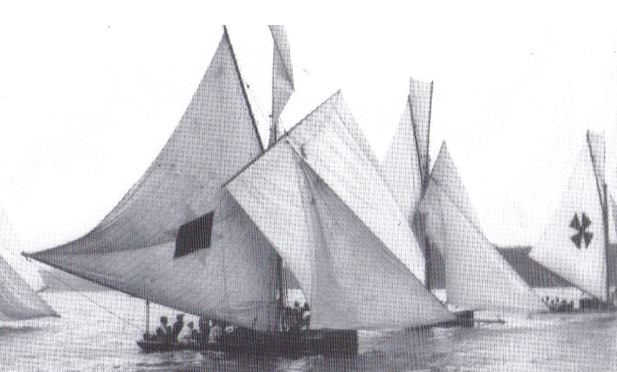
Guinevere working out of Johnstones Bay (East Balmain in the background, Goat Island at right) in what would likely be a Johnstones Bay Sailing Club race in 1896. The JBSC didn't require sail insignias at that time. Hall collection ANMM.
This article is by Bob Chapman, whose Great-Grandmother was the sister of the Dick Green mentioned who owned Guinevere for a time.
Guinevere was built as Aeolus in 1895 but sold and renamed Guinevere in 1896
AEOLUS 1885
Builder: William Reid, of Glebe Point.
Sail Insignia: not required for this era of skiff sailing
Owner: initially, would appear to be the Longfield brothers
The skiff did little racing when first launched; it was entered for the Anniversary Regatta in January 1885 as “Aeolus – 22ft, H. Longfield”. On 21 March 1885 it contested a match race against St. Crispin, owners listed as the Longfield brothers with a professional crew under skipper Newton, Aeolus won the match race by half a boat length.
Advertising for the sale of Aeolus in Oct 1885 and Jan 1886 provides some details of the skiff:
Ie 22 foot centre boarder, beam is 8ft 3in, built of cedar by Reid of Glebe Point.
An article published on 30 January 1897 in the Sydney Mail, under the title “Open Boat Sailing – the Old Boats” in regard to the 22-footers, advises: “Aeolus (now Guinevere), built by Reid, was the next boat to distinguish herself in this class”.
GUINEVERE 1886 - 1904
Sail Insignia: not required until it began to race with the Sydney Flying Squadron in 1900.
1897 – 1904, Black Diamond under ownership of R. Green.
Guinevere competes in the Balmain Regatta in Nov 1886, with “half-decked boats, 20-22ft overall, amateur crews”, skippered by H. Dinham (Harry Charles Dinham from Woolwich); regular competitor in Sydney Amateur S.C. events against half-decked boats in the 22ft range for the remainder of the season, usually restricted to working sails only and amateur crews. For 1887-88 continues with same format of racing under H. Dinham. Then has a break from racing for several years – may well have been used for recreational sailing.
March 1892, Guinevere entered in the “Champion 22-Footers’ Race” run by the Johnstone’s Bay Club, with skipper H. Carpenter. Nothing further heard about the skiff until January 1895 when it is listed as an entry for the Intercolonial 22t Championship held on Sydney Harbour on Sat 19 January 1895 with owner H. Dinham and skipper H.K. Carpenter. From all accounts this was a very significant event for the 22ft Class with 19 skiffs entered, Guinevere placed 13th. Three days later Guinevere was listed for sale by auction.
For the 1895-96 season Guinevere is owned / skippered by A.W. Crane (Arthur William Crane of Woolwich), and races with the newly formed Lane Cove Club (ie club’s first season) and the Sydney Amateur S.C. – these events were often mixed fleet handicap races that stipulated mainsail, jib & topsail only with limited crew numbers. For the Intercolonial Championship in January 1897 Guinevere was skippered by T. Colebrook. During the winter of 1897 A.W. Crane has a new 22 footer built by Dearing of Balmain, the Wonga that he will race with much success for many seasons with Sydney Amateurs and Johnstone’s Bay clubs.
1896-97 Guinevere is skippered by R. Edwards with the Lane Cove Club for the first few races.
For 1897-98 Guinevere is owned / skippered by Richard W. Green (1859 – 1933), shipwright from Greenwich, and is raced with the Lane Cove Club and North Sydney Sailing Club, as well as the usual regattas – Balmain, Anniversary Day. 1898-99 raced with the North Sydney S.C., and in March competes in an SFS race and a Johnstone’s Bay S.C. race by invitation at the end of the season. 1899-1900 raced with the North Sydney S.C. and Sydney S.C. (formed in Feb 1899). 1900-01, 1901-02, 1902-03, 1903-04, with Sydney Flying Squadron and Sydney S.C., under the Black Diamond sail insignia (as required for SFS events).
A race report from March 1902 states the following: “The old Guinevere is not yet done by securing a very popular win in the Flying Squadron Handicap. Dick Green was the recipient of numerous congratulations, for he is one of the right sort, and races for the pure love of the sport. We must join in the congratulations, and wish “Old Dick” a few more wins.”
In April 1903 Green advertised the Guinevere for sale, but it did not sell and he continued to race it for the 1903-04 season. He must have sold it at some stage as he subsequently built a new 18ft skiff Evelyn that he first raced from November 1906, carrying the same sail insignia, Black Diamond (…may have kept the rig off Guinevere?).
Richard Green had four sons, born from 1885 to 1889 (one set of twins), three of whom followed in his footsteps to learn the trade of boat building while the other became a plumber, they all developed into accomplished water boatmen (rowing and sailing). In addition, his sister Frances (Mrs F.A. Chapman) who lived nearby had four sons of similar age and no doubt the cousins spent a lot of time together engaged in similar interests.
A race report from October 1903 mentions the following: “Dick Green with his kindergarten aboard, gradually gained ground throughout, but Guinevere had to be content with fifth place”. Can’t help but thinking the “kindergarten” may well have included the young Greens and their Chapman cousins.
Above:22ft skiff Guinevere– sail insignia under Richard Green was a Black Diamond. Boat on the right of picture is the dual-hulled Flying Fish. Photo sourced from “Bluewater Bushmen” page 106.
This article is by Bob Chapman, whose Great-Grandmother was the sister of the Dick Green mentioned who owned Guinevere for a time.
Guinevere was built as Aeolus in 1895 but sold and renamed Guinevere in 1896
AEOLUS 1885
Builder: William Reid, of Glebe Point.
Sail Insignia: not required for this era of skiff sailing
Owner: initially, would appear to be the Longfield brothers
The skiff did little racing when first launched; it was entered for the Anniversary Regatta in January 1885 as “Aeolus – 22ft, H. Longfield”. On 21 March 1885 it contested a match race against St. Crispin, owners listed as the Longfield brothers with a professional crew under skipper Newton, Aeolus won the match race by half a boat length.
Advertising for the sale of Aeolus in Oct 1885 and Jan 1886 provides some details of the skiff:
Ie 22 foot centre boarder, beam is 8ft 3in, built of cedar by Reid of Glebe Point.
An article published on 30 January 1897 in the Sydney Mail, under the title “Open Boat Sailing – the Old Boats” in regard to the 22-footers, advises: “Aeolus (now Guinevere), built by Reid, was the next boat to distinguish herself in this class”.
GUINEVERE 1886 - 1904
Sail Insignia: not required until it began to race with the Sydney Flying Squadron in 1900.
1897 – 1904, Black Diamond under ownership of R. Green.
Guinevere competes in the Balmain Regatta in Nov 1886, with “half-decked boats, 20-22ft overall, amateur crews”, skippered by H. Dinham (Harry Charles Dinham from Woolwich); regular competitor in Sydney Amateur S.C. events against half-decked boats in the 22ft range for the remainder of the season, usually restricted to working sails only and amateur crews. For 1887-88 continues with same format of racing under H. Dinham. Then has a break from racing for several years – may well have been used for recreational sailing.
March 1892, Guinevere entered in the “Champion 22-Footers’ Race” run by the Johnstone’s Bay Club, with skipper H. Carpenter. Nothing further heard about the skiff until January 1895 when it is listed as an entry for the Intercolonial 22t Championship held on Sydney Harbour on Sat 19 January 1895 with owner H. Dinham and skipper H.K. Carpenter. From all accounts this was a very significant event for the 22ft Class with 19 skiffs entered, Guinevere placed 13th. Three days later Guinevere was listed for sale by auction.
For the 1895-96 season Guinevere is owned / skippered by A.W. Crane (Arthur William Crane of Woolwich), and races with the newly formed Lane Cove Club (ie club’s first season) and the Sydney Amateur S.C. – these events were often mixed fleet handicap races that stipulated mainsail, jib & topsail only with limited crew numbers. For the Intercolonial Championship in January 1897 Guinevere was skippered by T. Colebrook. During the winter of 1897 A.W. Crane has a new 22 footer built by Dearing of Balmain, the Wonga that he will race with much success for many seasons with Sydney Amateurs and Johnstone’s Bay clubs.
1896-97 Guinevere is skippered by R. Edwards with the Lane Cove Club for the first few races.
For 1897-98 Guinevere is owned / skippered by Richard W. Green (1859 – 1933), shipwright from Greenwich, and is raced with the Lane Cove Club and North Sydney Sailing Club, as well as the usual regattas – Balmain, Anniversary Day. 1898-99 raced with the North Sydney S.C., and in March competes in an SFS race and a Johnstone’s Bay S.C. race by invitation at the end of the season. 1899-1900 raced with the North Sydney S.C. and Sydney S.C. (formed in Feb 1899). 1900-01, 1901-02, 1902-03, 1903-04, with Sydney Flying Squadron and Sydney S.C., under the Black Diamond sail insignia (as required for SFS events).
A race report from March 1902 states the following: “The old Guinevere is not yet done by securing a very popular win in the Flying Squadron Handicap. Dick Green was the recipient of numerous congratulations, for he is one of the right sort, and races for the pure love of the sport. We must join in the congratulations, and wish “Old Dick” a few more wins.”
In April 1903 Green advertised the Guinevere for sale, but it did not sell and he continued to race it for the 1903-04 season. He must have sold it at some stage as he subsequently built a new 18ft skiff Evelyn that he first raced from November 1906, carrying the same sail insignia, Black Diamond (…may have kept the rig off Guinevere?).
Richard Green had four sons, born from 1885 to 1889 (one set of twins), three of whom followed in his footsteps to learn the trade of boat building while the other became a plumber, they all developed into accomplished water boatmen (rowing and sailing). In addition, his sister Frances (Mrs F.A. Chapman) who lived nearby had four sons of similar age and no doubt the cousins spent a lot of time together engaged in similar interests.
A race report from October 1903 mentions the following: “Dick Green with his kindergarten aboard, gradually gained ground throughout, but Guinevere had to be content with fifth place”. Can’t help but thinking the “kindergarten” may well have included the young Greens and their Chapman cousins.
Above:22ft skiff Guinevere– sail insignia under Richard Green was a Black Diamond. Boat on the right of picture is the dual-hulled Flying Fish. Photo sourced from “Bluewater Bushmen” page 106.
Irex 1887 or 1888
Builder: Joe Donnelly* for Nick Johnson.
Known dimensions: 9'6" beam.
Insignia: Blue crescent with red bar.
Irex was built in 1897 but may not have been launched until early 1898 as her earliest race I can find is the Anniversary regatta of 26 Jan 1888 in "All Boats 20' and over, limited crews" in which she was unplaced. She won several races in other Regattas and SASC races in her first two seasons but for some reason had the next two seasons off (perhaps Nick Johnson was busy or had gone on the long trip to the "old country"). Her first race back was the March 1892 JBSC 22' Championship in which George Fletcher (Holmes) Snr* steered her to victory. She was third in the same Championship race the next year.
In December 1893 Nick Johnson took Irex to Broken Bay (North of Sydney) for either some racing or camping, and on returning with only Nick Johnson and a crew Jack "Whipper" Johnson aboard she capsized offshore. With a number of sharks in sight, the two clung to the inverted hull. Nick jammed an oar in the centreboard slot and rigged the jib to it so the boat would blow offshore in the strong Nor'Westerly as he believed they could get into the path of the scheduled Gosford steamer. However they missed it, and were picked up nearly exhausted several hours later by the passing ketch Dewdrop. Irex was abandoned and thought to have been lost, but a New Zealand-bound steamer reported sighting her a couple of weeks later and the famous pilot steamer Captain Cook was sent out to tow her in. She was cleaned up and won her next race that January under George Holmes Snr.
In March 1894 she was the Intercolonial Champion, by winning the one race which was the rule in those days, held in Brisbane. She won the JBSC 22'Championship on her first race after returning from Brisbane. In the next Intercolonial match in March 1895 in Sydney Irex was second to Esmerelda. Regattas and JBSC and SFS races in the 1895-6 and 1896-7 seasons. At some stage in either 1895 or 1896 Nick Johnson sold Irex to A.Kinnimont who installed Fred Doran as the regular skipper. In January 1897 she repeated her win in the Intercolonial Championship in Sydney,under Fred Doran, beating the several new boats that had been built especially for the race. The above photo was taken on that day.
Early in the 1897-8 season Irex was unplaced in the JBSC Championship, but won the Balmain Regatta race. In January 1898 she went to Brisbane again for the Intercolonial Championship under George Ellis* and won the invitational race but was unplaced in the Championship race. On her return to Sydney in late January she was dismasted while leading in a JBSC handicap under T.Colebrook Jnr.
In March 1898 Kinnimont raffled Irex, and the winner T.Kemmis sold her the next day to Nick Johnson her original owner. Perhaps Nick knew something because soon afterwards he sold her to Mark Foy who shipped her to Britain to challenge the British. I'll tell the full story of this event at another time soon, its a fascinating tale, but suffice it to say that Irex was comprehensively beaten in 3 races by the local boat Maid of Kent. Irex didn't return to Sydney until February 1903. Her first race back was a SFS General Handicap in March in which she was unplaced under George Ellis, carrying new colours of a green shamrock. She appears in a few races with the Balmain Amateur Sailing Club in 1919-20 and 1920-21 seasons skippered by A.J.Pitt (although this could be a different boat), but the trail goes cold after this, but she is believed to have been sold to the Islands where she was wrecked.
Known dimensions: 9'6" beam.
Insignia: Blue crescent with red bar.
Irex was built in 1897 but may not have been launched until early 1898 as her earliest race I can find is the Anniversary regatta of 26 Jan 1888 in "All Boats 20' and over, limited crews" in which she was unplaced. She won several races in other Regattas and SASC races in her first two seasons but for some reason had the next two seasons off (perhaps Nick Johnson was busy or had gone on the long trip to the "old country"). Her first race back was the March 1892 JBSC 22' Championship in which George Fletcher (Holmes) Snr* steered her to victory. She was third in the same Championship race the next year.
In December 1893 Nick Johnson took Irex to Broken Bay (North of Sydney) for either some racing or camping, and on returning with only Nick Johnson and a crew Jack "Whipper" Johnson aboard she capsized offshore. With a number of sharks in sight, the two clung to the inverted hull. Nick jammed an oar in the centreboard slot and rigged the jib to it so the boat would blow offshore in the strong Nor'Westerly as he believed they could get into the path of the scheduled Gosford steamer. However they missed it, and were picked up nearly exhausted several hours later by the passing ketch Dewdrop. Irex was abandoned and thought to have been lost, but a New Zealand-bound steamer reported sighting her a couple of weeks later and the famous pilot steamer Captain Cook was sent out to tow her in. She was cleaned up and won her next race that January under George Holmes Snr.
In March 1894 she was the Intercolonial Champion, by winning the one race which was the rule in those days, held in Brisbane. She won the JBSC 22'Championship on her first race after returning from Brisbane. In the next Intercolonial match in March 1895 in Sydney Irex was second to Esmerelda. Regattas and JBSC and SFS races in the 1895-6 and 1896-7 seasons. At some stage in either 1895 or 1896 Nick Johnson sold Irex to A.Kinnimont who installed Fred Doran as the regular skipper. In January 1897 she repeated her win in the Intercolonial Championship in Sydney,under Fred Doran, beating the several new boats that had been built especially for the race. The above photo was taken on that day.
Early in the 1897-8 season Irex was unplaced in the JBSC Championship, but won the Balmain Regatta race. In January 1898 she went to Brisbane again for the Intercolonial Championship under George Ellis* and won the invitational race but was unplaced in the Championship race. On her return to Sydney in late January she was dismasted while leading in a JBSC handicap under T.Colebrook Jnr.
In March 1898 Kinnimont raffled Irex, and the winner T.Kemmis sold her the next day to Nick Johnson her original owner. Perhaps Nick knew something because soon afterwards he sold her to Mark Foy who shipped her to Britain to challenge the British. I'll tell the full story of this event at another time soon, its a fascinating tale, but suffice it to say that Irex was comprehensively beaten in 3 races by the local boat Maid of Kent. Irex didn't return to Sydney until February 1903. Her first race back was a SFS General Handicap in March in which she was unplaced under George Ellis, carrying new colours of a green shamrock. She appears in a few races with the Balmain Amateur Sailing Club in 1919-20 and 1920-21 seasons skippered by A.J.Pitt (although this could be a different boat), but the trail goes cold after this, but she is believed to have been sold to the Islands where she was wrecked.
Keriki 1898
Builder: Sam Williams* for Orlando (Lan) Taylor*.
Known Dimensions:Beam over planking 9'10" or 10', overall 11'5, depth 2'8" or 2'9", tuck 7'10" or 8', spring in keel 9" forward, 11 1/2" aft, sheer 11 1/2".
Rig Dimensions: 59'6" bumpkin to boom ends, 22' jib foot, main 36'on the boom, 22' hoist, 22' gaff, 40' leech. Ringtail 39' leech, spinnaker poles totalled 40'. Tops'l yard 21'.
Carried 15-25 hands.
Planking and case and thwarts Australian Red Cedar, timbers Elm, keel Spotted Gum, stem and stern knees Tea-Tree. She was described as having "the same shape as Australian*" (also designed and built by Williams, with finer lines than Plover*, another recently launched 22. She had "slightly hollow garboards", with "a good full bow and fine entrance, rather full on top....plenty of sheer, with a powerful-looking and pretty tuck".
Sail Insignia: Blue and red crescent (Lan Taylor's house colours).
Keriki was launched on October 16 1898 joining several other new 22's to take on the Intercolonial Challenge. George Ellis* took her for a spin that day, and also steered in her first race, a JBSC handicap on 5 November in which she was beaten by Effie and Plover, two of the other new boats. A fortnight later she had her first win under Lan Taylor. Ellis won the JBSC 22' Championship race in January 1899 and was second in the late January 1899 Intercolonial Championship race to Effie. Taylor and Ellis shared the tiller for the rest of that season and the next with some success but also with several capsizes. Chris Webb started to appear at the tiller in January 1900 when he was second in the JBSC 22' Championship on 14 January, and won the SFS 22' Championship on 20 January. Webb and Keriki won the Balmain Regatta in the early part of the 1900-01 season. Keriki continued to race in JBSC and SFS races for the next few seasons, with Taylor and Webb sharing the tiller. A sign of the times was that only Keriki and Plover entered for the SFS 22' Championship in the 1900-01 season and it was cancelled. Keriki kept racing regularly with the SFS and the new Sydney Sailing Club which had supplanted the JBCS, and was the only 22-footer regularlyracing. Plover and Effie put in occasional appearances but the 18-footers dominated the entry lists and had clearly taken over as the favourite boat of owners, skippers and punters. The last race I can find for Keriki was a general handicap at the Anniversary Day Regatta in January 1913. Taylor had Williams build him an 18-footer he called Quibree in 1912 which carried Taylor's red and blue crescent colours until he sold her in 1919 and in 1920 bought the new Norman Wright-built Thelma III and changed her name to Keriki and sailed her up until the end of the 1938-39 season.
Known Dimensions:Beam over planking 9'10" or 10', overall 11'5, depth 2'8" or 2'9", tuck 7'10" or 8', spring in keel 9" forward, 11 1/2" aft, sheer 11 1/2".
Rig Dimensions: 59'6" bumpkin to boom ends, 22' jib foot, main 36'on the boom, 22' hoist, 22' gaff, 40' leech. Ringtail 39' leech, spinnaker poles totalled 40'. Tops'l yard 21'.
Carried 15-25 hands.
Planking and case and thwarts Australian Red Cedar, timbers Elm, keel Spotted Gum, stem and stern knees Tea-Tree. She was described as having "the same shape as Australian*" (also designed and built by Williams, with finer lines than Plover*, another recently launched 22. She had "slightly hollow garboards", with "a good full bow and fine entrance, rather full on top....plenty of sheer, with a powerful-looking and pretty tuck".
Sail Insignia: Blue and red crescent (Lan Taylor's house colours).
Keriki was launched on October 16 1898 joining several other new 22's to take on the Intercolonial Challenge. George Ellis* took her for a spin that day, and also steered in her first race, a JBSC handicap on 5 November in which she was beaten by Effie and Plover, two of the other new boats. A fortnight later she had her first win under Lan Taylor. Ellis won the JBSC 22' Championship race in January 1899 and was second in the late January 1899 Intercolonial Championship race to Effie. Taylor and Ellis shared the tiller for the rest of that season and the next with some success but also with several capsizes. Chris Webb started to appear at the tiller in January 1900 when he was second in the JBSC 22' Championship on 14 January, and won the SFS 22' Championship on 20 January. Webb and Keriki won the Balmain Regatta in the early part of the 1900-01 season. Keriki continued to race in JBSC and SFS races for the next few seasons, with Taylor and Webb sharing the tiller. A sign of the times was that only Keriki and Plover entered for the SFS 22' Championship in the 1900-01 season and it was cancelled. Keriki kept racing regularly with the SFS and the new Sydney Sailing Club which had supplanted the JBCS, and was the only 22-footer regularlyracing. Plover and Effie put in occasional appearances but the 18-footers dominated the entry lists and had clearly taken over as the favourite boat of owners, skippers and punters. The last race I can find for Keriki was a general handicap at the Anniversary Day Regatta in January 1913. Taylor had Williams build him an 18-footer he called Quibree in 1912 which carried Taylor's red and blue crescent colours until he sold her in 1919 and in 1920 bought the new Norman Wright-built Thelma III and changed her name to Keriki and sailed her up until the end of the 1938-39 season.
Plover 1898
Builder: Joe Donnelly*, for Sam Hordern (Anthony Hordern & Sons department stores)
Known dimensions: Length 22', beam 10' across planking, 11' over mouldings, 2'8" deep, tuck 7'10" x 1'10", 9"+ spring in the keel.
Keel Tallowood, timbers Elm, 'turtleback deck'.
Insignia: Triangle, not sure of colour.
Raced with the Johnstone's Bay Sailing Club and Sydney Flying Squadron until the 1901-02 season, last known appearance at Balmain Regatta November 1907. Sam Hordern ordered her from Joe Donnelly in early 1898 after the dismal showing of Bronzewing V in January and February, a boat designed by Linton Hope and imported from England. She was one of the "cracks" and had many close battles with Effie* and Vigilant*.
In 1899 she was fitted with hollow spars and mast by the builder Joe Donnelly, and was possibly the first open boat to carry hollow spars.
Known dimensions: Length 22', beam 10' across planking, 11' over mouldings, 2'8" deep, tuck 7'10" x 1'10", 9"+ spring in the keel.
Keel Tallowood, timbers Elm, 'turtleback deck'.
Insignia: Triangle, not sure of colour.
Raced with the Johnstone's Bay Sailing Club and Sydney Flying Squadron until the 1901-02 season, last known appearance at Balmain Regatta November 1907. Sam Hordern ordered her from Joe Donnelly in early 1898 after the dismal showing of Bronzewing V in January and February, a boat designed by Linton Hope and imported from England. She was one of the "cracks" and had many close battles with Effie* and Vigilant*.
In 1899 she was fitted with hollow spars and mast by the builder Joe Donnelly, and was possibly the first open boat to carry hollow spars.
Portia 1888
The 22-footer Portia . The number of crew and their casual dress might suggest a picnic day, but they appear to be displaying a number so it could be a Regatta. This appears to be before sail insignias were introduced in 1893, but there was a bit of an overlap for several seasons, and the Johnstone’s Bay Sailing Club did not insist on sail insignias.
Builder and sail insignia unknown.
Portia was one of the early 22-footers, first appearing in 1888 and racing with various clubs including the Johnstone’s Bay Sailing Club and the SASC and was a good enough performer to attract top skippers like George Holmes Jnr and George Ellis. Portia appeared in the first few intercolonial Challenges, in Brisbane in 1894 and Sydney in 1895 but was outclassed by the newer 22-footers in the late 1890’s. I haven’t found a record of her sailing after the Anniversary Day Regatta in 1896, but she may have ended her days sailing in smaller suburban clubs until the early 1900s as many other 22-footers did. These events generally attracted little interest in newspapers.
Builder and sail insignia unknown.
Portia was one of the early 22-footers, first appearing in 1888 and racing with various clubs including the Johnstone’s Bay Sailing Club and the SASC and was a good enough performer to attract top skippers like George Holmes Jnr and George Ellis. Portia appeared in the first few intercolonial Challenges, in Brisbane in 1894 and Sydney in 1895 but was outclassed by the newer 22-footers in the late 1890’s. I haven’t found a record of her sailing after the Anniversary Day Regatta in 1896, but she may have ended her days sailing in smaller suburban clubs until the early 1900s as many other 22-footers did. These events generally attracted little interest in newspapers.
Sappho 1886
Built by Barnett in Berry's Bay on spec in 1886, Sappho, an early 22-footer was clinker-planked, painted and undecked , before the standardisation to batten-seam carvel varnished Cedar in the 1890s. She is reported as winning a handicap race "for pleasure boats only" (ie no working boats) at the Sydney Amateur Sailing Club in December 1888, owned by GS Buzacott (or Bamcott in another report) but sailed by H Pickering. She raced in the Anniversary Day Regatta in January 1889 and was unplaced. A Sappho appears in a Snail's Bay Sailing Club race in March 1889 and it may be the same boat, but she mostly raced with the Sydney Amateurs in 1889-1890. She raced with the Lane Cove Amateur Sailing Club in March 1892, and a mention of her in a Lane Cove race in January 1894 is the last report I can find. Most of her races appear to have been in events with limited sails and crews, and these were often not reported. She definitely never raced with the main fleet of 22-footers which built up in the early 1890s.
Vigilant 1896
Builder: William Golding* for a "syndicate of 20 young fellows". Generally steered by Billy Read*, one of the syndicate.
Known dimensions: 10' beam over planking, 11' over gun'ls, 2'5" deep, 9' beam at mast thwart, 8' at tuck. "Only" 3" spring in keel for'd, 2" aft.
Planking, tuck, deck, thwarts, case Cedar, keel Bluegum, stem Tea-tree, sternpost Colonial Teak, timbers Hickory (Blackwood), moulding and stringers Kauri, knees Tea-tree and Oak. Dingwall sails, main 32' on boom, jib 15' outboard.
Insignia: P & O flag.
One of four new 22-footers built in 1896 (Vigilant, Effie*, Figtree and Wonga*) with the intention of winning back the Intercolonial title from Queensland,Vigilant's first race was in the Drummoyne Regatta on 16 January 1897 where Billy Read unfortunately sailed her into a calm and around the wrong mark. The fifth Intercolonial Championship was on Sat 24 January and Vigilant was third to the old Irex and Figtree. The Queenslanders salvaged a bit of pride by winning the 22-Footers race at Monday 26 January's Anniversary Day Regatta with the elderly Bulletin* with Billy Read bringing Vigilant in second. She won several handicap events with the JBSC and the SFS and competed in some SASC races as well in the rest of the 1896-7 season.
In November 1897 Vigilant won the JBSC 22-Footers Championship but was unplaced in the December SFS Championship, won by Effie. This was basically the story of her life, winning quite a few races but more often than not being beaten by Effie (although she won equal first prize money to Effie in the 1897-8 season), and later by a new boat Keriki.
Vigilant was offered at auction in October 1901 but drew no bids. The Queenslanders had dropped the lip about losing the final few Intercolonials so comprehensively and withrew from competition. Without this stimulus, and with the newer 18-footers beginning to increase in numbers and popularity with the punters, 22-footer racing began to wane. An effort was made to revive it in 1902-3, but after that 22-footers appeared only in general handicaps and smaller local club racing.
Vigilant was apparently put into the hired boats trade, with limited sails, but apparently not limited enough as she capsized and one of her hirers was drowned in October 1907. I have not been able to determine what happened to her after that.
Known dimensions: 10' beam over planking, 11' over gun'ls, 2'5" deep, 9' beam at mast thwart, 8' at tuck. "Only" 3" spring in keel for'd, 2" aft.
Planking, tuck, deck, thwarts, case Cedar, keel Bluegum, stem Tea-tree, sternpost Colonial Teak, timbers Hickory (Blackwood), moulding and stringers Kauri, knees Tea-tree and Oak. Dingwall sails, main 32' on boom, jib 15' outboard.
Insignia: P & O flag.
One of four new 22-footers built in 1896 (Vigilant, Effie*, Figtree and Wonga*) with the intention of winning back the Intercolonial title from Queensland,Vigilant's first race was in the Drummoyne Regatta on 16 January 1897 where Billy Read unfortunately sailed her into a calm and around the wrong mark. The fifth Intercolonial Championship was on Sat 24 January and Vigilant was third to the old Irex and Figtree. The Queenslanders salvaged a bit of pride by winning the 22-Footers race at Monday 26 January's Anniversary Day Regatta with the elderly Bulletin* with Billy Read bringing Vigilant in second. She won several handicap events with the JBSC and the SFS and competed in some SASC races as well in the rest of the 1896-7 season.
In November 1897 Vigilant won the JBSC 22-Footers Championship but was unplaced in the December SFS Championship, won by Effie. This was basically the story of her life, winning quite a few races but more often than not being beaten by Effie (although she won equal first prize money to Effie in the 1897-8 season), and later by a new boat Keriki.
Vigilant was offered at auction in October 1901 but drew no bids. The Queenslanders had dropped the lip about losing the final few Intercolonials so comprehensively and withrew from competition. Without this stimulus, and with the newer 18-footers beginning to increase in numbers and popularity with the punters, 22-footer racing began to wane. An effort was made to revive it in 1902-3, but after that 22-footers appeared only in general handicaps and smaller local club racing.
Vigilant was apparently put into the hired boats trade, with limited sails, but apparently not limited enough as she capsized and one of her hirers was drowned in October 1907. I have not been able to determine what happened to her after that.
Wonga 1896
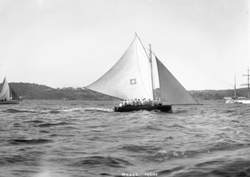
Builder: Edgar Dearing Jnr* of Balmain for A.W.Crane.
Known dimensions: Beam 9'1" over planking, 9'10" over mouldings, mast thwart 7'2", tuck 7'wide, depth 2'8". Spotted Gum keel 10" x 2", 5 1/2" spring forward, 4 1/2" aft. Stem and sternpost colonial Teak (Crow's Ash), Cedar planking (all one length), Cedar thwarts and decks. Ash coamings and mouldings, timbers Hickory (Blackwood), runner and shroud plates inside, "practically no deck aft".
Wonga was launched on Saturday 22 August 1896 and had her first race on 26 September, the day this photo (from the Hall Collection, ANMM) was taken, with W.Holmes at the tiller. The owner Mr Crane was still the owner of Guinevere, an earlier 22-footer and it appears that the rig in the photo is that of Guinevere, as a complete new rig with spars by Dearing and sails by Carter was reported as fitted in mid-October. It was not an auspicious start, she broke a shroud and withdrew from the race. Other than a third at the Balmain regatta that year, Wonga was not particularly successful in its early races, in spite of mostly having the legend George Holmes* at the tiller. George Ellis* took over the tiller early in 1897 and the boat began to do better in races with the Johnstones Bay SC and the SFS. Crane occasionally steered himself, and Jack Smith is also seen. The other new boats built in the same year under the stimulus of Intercolonial competition with Queensland, Vigilant and Effie, and Plover of 1898 were faster. Crane sold Wonga to H.L.Carter in November 1899, and she was re-named Kelpie. Used mostly as a pleasure boat, Kelpie occasionally appeared in 22' Championships just to make up the numbers, but mostly raced in limited sails and crews events. In October 1903 a 22' Wonga was registered with the new Neutral Bay SC by owner P.Roberts and this is probably the same boat, but is rarely mentioned again.
Known dimensions: Beam 9'1" over planking, 9'10" over mouldings, mast thwart 7'2", tuck 7'wide, depth 2'8". Spotted Gum keel 10" x 2", 5 1/2" spring forward, 4 1/2" aft. Stem and sternpost colonial Teak (Crow's Ash), Cedar planking (all one length), Cedar thwarts and decks. Ash coamings and mouldings, timbers Hickory (Blackwood), runner and shroud plates inside, "practically no deck aft".
Wonga was launched on Saturday 22 August 1896 and had her first race on 26 September, the day this photo (from the Hall Collection, ANMM) was taken, with W.Holmes at the tiller. The owner Mr Crane was still the owner of Guinevere, an earlier 22-footer and it appears that the rig in the photo is that of Guinevere, as a complete new rig with spars by Dearing and sails by Carter was reported as fitted in mid-October. It was not an auspicious start, she broke a shroud and withdrew from the race. Other than a third at the Balmain regatta that year, Wonga was not particularly successful in its early races, in spite of mostly having the legend George Holmes* at the tiller. George Ellis* took over the tiller early in 1897 and the boat began to do better in races with the Johnstones Bay SC and the SFS. Crane occasionally steered himself, and Jack Smith is also seen. The other new boats built in the same year under the stimulus of Intercolonial competition with Queensland, Vigilant and Effie, and Plover of 1898 were faster. Crane sold Wonga to H.L.Carter in November 1899, and she was re-named Kelpie. Used mostly as a pleasure boat, Kelpie occasionally appeared in 22' Championships just to make up the numbers, but mostly raced in limited sails and crews events. In October 1903 a 22' Wonga was registered with the new Neutral Bay SC by owner P.Roberts and this is probably the same boat, but is rarely mentioned again.
